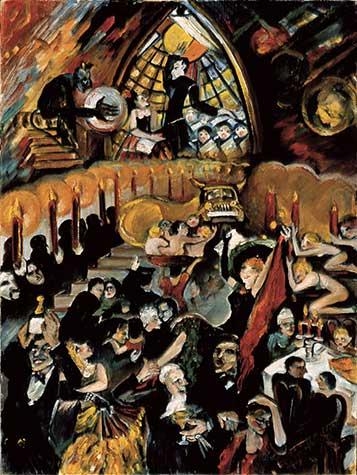Worship of the Golden Calf
1951, oil on canvas, 20" x 16
FROM THE FOREWORD BY JOANNA WEBER TO "MELA" BY RICHARD T. HILL
Every act of painting, every creative act, is an act of self-definition as well as an attempt at defining the world around us. In Mela's compositions, the horrors of world events and her dramatic personal biography are intertwined. Particularly in her later pieces, we sense a chasm, a dislocation and distortion, which she is clearly trying to locate and tame. She paints violence to balance need and responsibility, especially in Everything Money Can Buy (1950), and Worship of the Golden Calf (1951), which both show the way of no return. Faith in America–symbolized by the Statue of Liberty–is false, as is faith in money. Only love and caring can stave off the vices that at first appear so innocent but that ultimately destroy, not only oneself, but also the world.
Her work is strong and grounded in the vocabulary of the post-World War I Expressionists. Formally, Mela's art resembles Käthe Kollwitz, George Grosz, James Ensor and Max Beckmann, with grotesque and exaggerated forms in carefully constructed, complicated scenes filled with words and dark shadows–all of which communicate a volatile atmosphere. Her palette is dark, and her paint, thick. As with French artist Georges Rouault, the paintings feel built up, like macabre stained glass windows painted on canvas. Stark contrasts delineate the picture plane, oftentimes shedding a sickly light on the darkness. Demonstrating awareness of the importance of cubism, she breaks that plane.
Seduced by the festive colors in Wassily Kandinsky's early apocalyptic visions, viewers find themselves in a world gone upside down. Likewise, Mela incorporates a social realist perspective reminiscent of other emigrant artists, such as Ben Shahn's work of the 1930s, notably in his rendering of the Sacco and Vanzetti trials. Philip Guston's paintings of the hooded Klansmen of Los Angeles in the 1930s, as well as his later shrouded figures (1960s), starkly portray social injustice. The importance of taking a stand, even through the genteel act of painting, permeates these urgent images. So, too, was Mela driven to expose the unattractive, the rough, the difficult–thereby participating in the struggle for change.
- Joanna Weber, Assistant Curator of European and Contemporary Art, Yale University Art Gallery, 2002
MELA'S TEN COMMANDMENTS
- Thou shalt help others.
- Thou shalt love.
- Thou shalt have ideals.
- Thou shalt fight for those ideals.
- Thou shalt be factual.
- Thou shalt not humiliate.
- Thou shalt give of one's self generously.
- Thou shalt be thankful.
- Thou shalt not kill with words or weapons.
- Thou shalt not poison with words or chemicals.
Written by Melanie Kent Steinhardt, translated from German, ca 1930's
© Richard T. Hill 2002 www.rabbithillpress.com/MELA.html
